Fractal Theory in Thin Films: Literature Review and Bibliometric Evidence on Applications and Trends
Abstract
:1. Introduction
2. Materials and Methods
3. Results and Discussion
3.1. Characteristics of Retrieved Publications
3.2. Publication Growth Trend
3.3. Analysis of Journals and Categories
3.3.1. Journal Analysis
3.3.2. Analysis of Categories
3.4. Keyword Analysis
3.5. Analysis of Regions and Institutions
3.5.1. Region
3.5.2. Institutions
3.6. Author Analysis
3.7. Applications and Future Directions
4. Conclusions
Author Contributions
Funding
Institutional Review Board Statement
Informed Consent Statement
Data Availability Statement
Acknowledgments
Conflicts of Interest
References
- Mwema, F.M.; Jen, T.-C.; Zhu, L. Thin Film Coatings; CRC Press: Boca Raton, FL, USA, 2022; ISBN 9781003202615. [Google Scholar]
- Tondare, R.S.; Shivaraj, B.W.; Narasimhamurthy, H.N.; Krishna, M.; Subramanyam, T.K. Effect of deposition time on structural, electrical and optical properties of Aluminium doped ZnO thin films by RF magnetron sputtering. Mater. Today Proc. 2018, 5, 2710–2715. [Google Scholar] [CrossRef]
- Le, M.-T.; Sohn, Y.-U.; Lim, J.-W.; Choi, G.-S. Effect of Sputtering Power on the Nucleation and Growth of Cu Films Deposited by Magnetron Sputtering. Mater. Trans. 2010, 51, 116–120. [Google Scholar] [CrossRef]
- Gudi, S.; Radoševi, J.; Kliški, M. Study of passivation of Al and Al-Sn alloys in borate buffer solutions using electrochemical impedance spectroscopy. Electrochim. Acta 2002, 47, 3009–3016. [Google Scholar] [CrossRef]
- Oluwatosin Abegunde, O.; Titilayo Akinlabi, E.; Philip Oladijo, O.; Akinlabi, S.; Uchenna Ude, A. Overview of thin film deposition techniques. AIMS Mater. Sci. 2019, 6, 174–199. [Google Scholar] [CrossRef]
- Mandelbrot, B.B. Self-Aff ine Fractals and Fractal Dimension. Phys. Scr. 1985, 32, 257–260. [Google Scholar] [CrossRef]
- Mandelbrot, B. How Long Is the Coast of Britain? Statistical Self-Similarity and Fractional Dimension. Science 1967, 156, 636–638. [Google Scholar] [CrossRef]
- Wilson, T.H. Some distinctions between self-similar and self-affine estimates of fractal dimension with case history. Math. Geol. 2000, 32, 319–335. [Google Scholar] [CrossRef]
- Olsen, L. A Multifractal Formalism. Adv. Math. N. Y. 1995, 116, 82–196. [Google Scholar] [CrossRef]
- Selmi, B. A Review on Multifractal Analysis of Hewitt–Stromberg Measures. J. Geom. Anal. 2022, 32, 12. [Google Scholar] [CrossRef]
- Jacquin, A. An introduction to fractals and their applications in electrical engineering. J. Frankl. Inst. 1994, 331, 659–680. [Google Scholar] [CrossRef]
- Li, J.; Du, Q.; Sun, C. An improved box-counting method for image fractal dimension estimation. Pattern Recognit. 2009, 42, 2460–2469. [Google Scholar] [CrossRef]
- Chow, W.C. Fractal (fractional) Brownian motion. Wiley Interdiscip. Rev. Comput. Stat. 2011, 3, 149–162. [Google Scholar] [CrossRef]
- Klinkenberg, B. A review of methods used to determine the fractal dimension of linear features. Math. Geol. 1994, 26, 23–46. [Google Scholar] [CrossRef]
- van Eck, N.J.; Waltman, L. Software survey: VOSviewer, a computer program for bibliometric mapping. Scientometrics 2010, 84, 523–538. [Google Scholar] [CrossRef]
- Donthu, N.; Kumar, S.; Mukherjee, D.; Pandey, N.; Lim, W.M. How to conduct a bibliometric analysis: An overview and guidelines. J. Bus. Res. 2021, 133, 285–296. [Google Scholar] [CrossRef]
- Small, H. Co-citation in the scientific literature: A new measure of the relationship between two documents. J. Am. Soc. Inf. Sci. 1973, 24, 265–269. [Google Scholar] [CrossRef]
- Mas-Tur, A.; Roig-Tierno, N.; Sarin, S.; Haon, C.; Sego, T.; Belkhouja, M.; Porter, A.; Merigó, J.M. Co-citation, bibliographic coupling and leading authors, institutions and countries in the 50 years of Technological Forecasting and Social Change. Technol. Forecast. Soc. Chang. 2021, 165, 120487. [Google Scholar] [CrossRef]
- Nyika, J.; Dinka, M. A scientometric study on quantitative microbial risk assessment in water quality analysis across 6 years (2016–2021). J. Water Health 2022, 20, 329–343. [Google Scholar] [CrossRef]
- Nyika, J.; Mwema, F.M.; Mahamood, R.M.; Akinlabi, E.T.; Jen, T. A five-year scientometric analysis of the environmental effects of 3D printing. Adv. Mater. Process. Technol. 2021, 1–11. [Google Scholar] [CrossRef]
- Sendhil, R.; Nyika, J.; Yadav, S.; Mackolil, J.; Workie, E.; Ragupathy, R.; Ramasundaram, P. Genetically modified foods: Bibliometric analysis on consumer perception and preference. GM Crops Food 2022, 13, 65–85. [Google Scholar] [CrossRef]
- Nyika, J.; Mackolil, J.; Workie, E.; Adhav, C.; Ramadas, S. Cellular agriculture research progress and prospects: Insights from bibliometric analysis. Curr. Res. Biotechnol. 2021, 3, 215–224. [Google Scholar] [CrossRef]
- Shameli, M.A.; Yousefi, L. Absorption enhanced thin-film solar cells using fractal nano-structures. IET Optoelectron. 2021, 15, 248–253. [Google Scholar] [CrossRef]
- Kazerooni, H.; Khavasi, A. Plasmonic fractals: Ultrabroadband light trapping in thin film solar cells by a Sierpinski nanocarpet. Opt. Quantum Electron. 2014, 46, 751–757. [Google Scholar] [CrossRef]
- Kamathe, V.; Nagar, R. Morphology-driven gas sensing by fabricated fractals: A review. Beilstein J. Nanotechnol. 2021, 12, 1187–1208. [Google Scholar] [CrossRef] [PubMed]
- Torkhov, N.A.; Evstigneev, M.P.; Kokolov, A.A.; Babak, L.I. The Fractal Geometry of TiAlNiAu Thin Film Metal System and Its Sheet Resistance (Lateral Size Effect). Symmetry 2021, 13, 2391. [Google Scholar] [CrossRef]
- Marques, I.H.G.; Saraiva Matos, R.; Romaguera-Barcelay, Y.; Ţălu, Ş.; Moreira, J.A.; Almeida, A.; de Cruz, J.P.; da Fonseca Filho, H.D. Investigation of Stereometric and Fractal Patterns of Spin-Coated LuMnO3 Thin Films. Adv. Mater. Sci. Eng. 2021, 2021, 9912247. [Google Scholar] [CrossRef]
- Majumdar, A.; Bhushan, B. Fractal Model of Elastic-Plastic Contact Between Rough Surfaces. J. Tribol. 1991, 113, 1–11. [Google Scholar] [CrossRef]
- Bouda, M.; Caplan, J.S.; Saiers, J.E. Box-Counting Dimension Revisited: Presenting an Efficient Method of Minimizing Quantization Error and an Assessment of the Self-Similarity of Structural Root Systems. Front. Plant Sci. 2016, 7, 149. [Google Scholar] [CrossRef]
- Fan, J.A.; Yeo, W.-H.; Su, Y.; Hattori, Y.; Lee, W.; Jung, S.-Y.; Zhang, Y.; Liu, Z.; Cheng, H.; Falgout, L.; et al. Fractal design concepts for stretchable electronics. Nat. Commun. 2014, 5, 3266. [Google Scholar] [CrossRef] [PubMed]
- Roe, E.T.; Bies, A.J.; Montgomery, R.D.; Watterson, W.J.; Parris, B.; Boydston, C.R.; Sereno, M.E.; Taylor, R.P. Fractal solar panels: Optimizing aesthetic and electrical performances. PLoS ONE 2020, 15, e0229945. [Google Scholar] [CrossRef] [Green Version]
- Ţălu, Ş.; Stach, S.; Raoufi, D.; Hosseinpanahi, F. Film thickness effect on fractality of tin-doped In2O3 thin films. Electron. Mater. Lett. 2015, 11, 749–757. [Google Scholar] [CrossRef]
- Arabatzis, I.M.; Stergiopoulos, T.; Bernard, M.C.; Labou, D.; Neophytides, S.G.; Falaras, P. Silver-modified titanium dioxide thin films for efficient photodegradation of methyl orange. Appl. Catal. B Environ. 2003, 42, 187–201. [Google Scholar] [CrossRef]
- Țălu, Ș.; Ghaderi, A.; Stępień, K.; Mwema, F.M. Advanced Micromorphology Analysis of Cu/Fe NPs Thin Films. IOP Conf. Ser. Mater. Sci. Eng. 2019, 611, 012016. [Google Scholar] [CrossRef]
- Ţălu, Ş.; Stach, S.; Valedbagi, S.; Bavadi, R.; Elahi, S.M.; Ţălu, M. Multifractal characteristics of titanium nitride thin films. Mater. Sci. 2015, 33, 541–548. [Google Scholar] [CrossRef]
- Mwema, F.M.; Akinlabi, E.T.; Oladijo, O.P. Sputtered Thin Films: Theory and Fractal Descriptions; CRC Press: Boca Raton, FL, USA, 2021; ISBN 9780367492564. [Google Scholar]
- Mwema, F.M.; Akinlabi, E.T.; Oladijo, O.P. Micromorphology and nanomechanical characteristics of sputtered aluminum thin films. Materwiss. Werksttech. 2020, 51, 787–791. [Google Scholar] [CrossRef]
- Țălu, Ș.; Yadav, R.P.; Mittal, A.K.; Achour, A.; Luna, C.; Mardani, M.; Solaymani, S.; Arman, A.; Hafezi, F.; Ahmadpourian, A.; et al. Application of Mie theory and fractal models to determine the optical and surface roughness of Ag–Cu thin films. Opt. Quantum Electron. 2017, 49, 256. [Google Scholar] [CrossRef]
- Shakoury, R.; Grayeli Korpi, A.; Ghosh, K.; Ţǎlu, Ş.; Rezaee, S.; Mwema, F.; Mardani, M.; Arman, A. Stereometric and scaling law analysis of surface morphology of stainless steel type AISI 304 coated with Mn: A conventional and fractal evaluation. Mater. Res. Express 2019, 6, 116436. [Google Scholar] [CrossRef]
- Ţəlu, Ş.; Patra, N.; Salerno, M. Micromorphological characterization of polymer-oxide nanocomposite thin films by atomic force microscopy and fractal geometry analysis. Prog. Org. Coat. 2015, 89, 50–56. [Google Scholar] [CrossRef]
- Valle, F.; Brucale, M.; Chiodini, S.; Bystrenova, E.; Albonetti, C. Nanoscale morphological analysis of soft matter aggregates with fractal dimension ranging from 1 to 3. Micron 2017, 100, 60–72. [Google Scholar] [CrossRef]
- Mwema, F.M.; Akinlabi, E.T.; Oladijo, O.P.; Akinlabi, S.A.; Hassan, S. Effect of AFM Scan Size on the Scaling Law of Sputtered Aluminium Thin Films. In Advances in Manufacturing Engineering, Lecture Notes in Mechanical Engineerin; Springer: Singapore, 2020; pp. 171–176. ISBN 9789811557538. [Google Scholar]
- Ţălu, Ş.; Bramowicz, M.; Kulesza, S.; Ghaderi, A.; Solaymani, S.; Savaloni, H.; Babaei, R. Micromorphology analysis of specific 3-D surface texture of silver chiral nanoflower sculptured structures. J. Ind. Eng. Chem. 2016, 43, 164–169. [Google Scholar] [CrossRef]
- Mwema, F.M.; Akinlabi, E.T.; Oladijo, O.P. Fractal Analysis of Thin Films Surfaces: A Brief Overview. In Advances in Material Sciences and Engineering, Lecture Notes in Mechanical Engineering; Springer: Singapore, 2020; pp. 251–263. [Google Scholar]
- Ghosh, K.; Pandey, R.K. Power spectral density-based fractal analysis of annealing effect in low cost solution-processed Al-doped ZnO thin films. Phys. Scr. 2019, 94, 115704. [Google Scholar] [CrossRef]
- Ghosh, K.; Pandey, R.K. Fractal and multifractal analysis of In-doped ZnO thin films deposited on glass, ITO, and silicon substrates. Appl. Phys. A 2019, 125, 98. [Google Scholar] [CrossRef]
- Dinner, O.; Paz, Y.; Grader, G.S. Orthogonal fractal growth of CsI domains forming a ladder-like structure. Thin Solid Films 2018, 661, 108–115. [Google Scholar] [CrossRef]
- Karan, S.; Mallik, B. Power spectral density analysis and photoconducting behavior in copper(ii) phthalocyanine nanostructured thin films. Phys. Chem. Chem. Phys. 2008, 10, 6751. [Google Scholar] [CrossRef] [PubMed]
- Zhou, W.; Cao, Y.; Zhao, H.; Li, Z.; Feng, P.; Feng, F. Fractal Analysis on Surface Topography of Thin Films: A Review. Fractal Fract. 2022, 6, 135. [Google Scholar] [CrossRef]
- Sun, X.; Fu, Z.; Wu, Z. Multifractal analysis and scaling range of ZnO AFM images. Phys. A Stat. Mech. Appl. 2002, 311, 327–338. [Google Scholar] [CrossRef]
- Mwema, F.M.; Akinlabi, E.T.; Oladijo, O.P. Demystifying Fractal Analysis of Thin Films: A Reference for Thin Film Deposition Processes; Springer: Singapore, 2021; ISBN 9789811544873. [Google Scholar]
- Maity, G.; Yadav, R.P.; Singhal, R.; Kulriya, P.K.; Mishra, A.; Som, T.; Dhar, S.; Kanjilal, D.; Patel, S.P. Influence of fractal and multifractal morphology on the wettability and reflectivity of crystalline-Si thin film surfaces as photon absorber layers for solar cell. J. Appl. Phys. 2021, 129, 045301. [Google Scholar] [CrossRef]
- Kalagi, S.S.; Patil, P.S. Studies on electrochemical activity of CNT/PANI composite thin film coating on ITO coated glass surfaces: Effect of concentration on fractal dimension. Electrochim. Acta 2017, 231, 521–528. [Google Scholar] [CrossRef]
- Das, A.; Matos, R.S.; Pinto, E.P.; Yadav, R.P.; Ţălu, Ş.; Kumar, S. 3D micromorphology-contact resistance-conductivity insights of quasi 2D Cd1-xPbxS thin films: Investigation based on stereometric and fractal analysis. Mater. Chem. Phys. 2022, 278, 125635. [Google Scholar] [CrossRef]
- Mwema, F.M.; Akinlabi, E.T.; Oladijo, O.P. Fractal analysis of hillocks: A case of RF sputtered aluminum thin films. Appl. Surf. Sci. 2019, 489, 614–623. [Google Scholar] [CrossRef]
- Adeniyi, A.; Mbaya, R.; Popoola, P.; Gomotsegang, F.; Ibrahim, I.; Onyango, M. Predicting the fouling tendency of thin film composite membranes using fractal analysis and membrane autopsy. Alex. Eng. J. 2020, 59, 4397–4407. [Google Scholar] [CrossRef]
- Xie, T.; Chen, D.; Xu, Y.; Wang, Y.; Li, M.; Zhang, Z.; Yang, J. High absorption and a tunable broadband absorption based on the fractal Technology of Infrared Metamaterial Broadband Absorber. Diam. Relat. Mater. 2022, 123, 108872. [Google Scholar] [CrossRef]
- Voss, R.F.; Laibowitz, R.B.; Allessandrini, E.I. Fractal (Scaling) Clusters in Thin Gold Films near the Percolation Threshold. Phys. Rev. Lett. 1982, 49, 1441–1444. [Google Scholar] [CrossRef]
- Ding, J.R.; Liu, B.X. Fractal aggregation of magnetic particles in Ag-Co thin-film surfaces. Phys. Rev. B 1989, 40, 5834–5836. [Google Scholar] [CrossRef] [PubMed]
- Liu, B.X.; Wang, J.; Fang, Z.Z. Diffusion-limited aggregation-like structure induced in Co thin films by carbon ion implantation. J. Phys. Condens. Matter 1991, 3, 9551–9557. [Google Scholar] [CrossRef]
- Niklasson, G.A.; Rönnow, D.; Strømme Mattsson, M.; Kullman, L.; Nilsson, H.; Roos, A. Surface roughness of pyrolytic tin dioxide films evaluated by different methods. Thin Solid Films 2000, 359, 203–209. [Google Scholar] [CrossRef]
- Toyama, T.; Sobajima, Y.; Okamoto, H. Fractal study of surface nanostructures of microcrystalline silicon films: From growth kinetics to electronic transport. Philos. Mag. 2009, 89, 2491–2504. [Google Scholar] [CrossRef]
- Trapalis, C.; Todorova, N.; Anastasescu, M.; Anastasescu, C.; Stoica, M.; Gartner, M.; Zaharescu, M.; Stoica, T. Atomic force microscopy study of TiO2 sol–gel films thermally treated under NH3 atmosphere. Thin Solid Films 2009, 517, 6243–6247. [Google Scholar] [CrossRef]
- Solookinejad, G.; Rozatian, A.S.H.; Habibi, M.H. Zinc Oxide Thin Films Characterization, AFM, XRD and X-ray Reflectivity. Exp. Tech. 2016, 40, 1297–1306. [Google Scholar] [CrossRef]
- Arjomandi, J.; Raoufi, D.; Ghamari, F. Surface Characterization and Morphology of Conducting Polypyrrole Thin Films during Polymer Growth on ITO Glass Electrode. J. Phys. Chem. C 2016, 120, 18055–18065. [Google Scholar] [CrossRef]
- Kavyashree; Yadav, R.P.; Parveen, S.; Pradhan Joshi, L.; Pandey, S.N. Fractal characterization of flakes covered tuberose structured Cu:Sr(OH)2 thin film as supercapacitive electrode. Mater. Res. Bull. 2019, 120, 110574. [Google Scholar] [CrossRef]
- Prajapat, R.; Sharma, Y.C. Morphological characterization and microstructural study of Cu2ZnSnSe4 thin films with compositional variation. Mater. Res. Express 2019, 6, 116459. [Google Scholar] [CrossRef]
- Eftekhari, L.; Raoufi, D. Crystallography characteristics of tetragonal nano-zirconia films under various oxygen partial pressure. Surf. Eng. 2019, 35, 618–626. [Google Scholar] [CrossRef]
- Astinchap, B. Fractal and statistical characterization of Ti thin films deposited by RF-magnetron sputtering: The effects of deposition time. Optik 2019, 178, 231–242. [Google Scholar] [CrossRef]
- Ţălu, Ş.; Abdolghaderi, S.; Pinto, E.P.; Matos, R.S.; Salerno, M. Advanced fractal analysis of nanoscale topography of Ag/DLC composite synthesized by RF-PECVD. Surf. Eng. 2020, 36, 713–719. [Google Scholar] [CrossRef]
- Ghribi, F.; El Mir Mabrouk, L.; Djessas, K.; Ţălu, Ş. Effect of substrate type on RF magnetron sputtered CuInS2 thin films properties based on nanoparticles synthesized by solvothermal route. Appl. Phys. A 2020, 126, 805. [Google Scholar] [CrossRef]
- Jahangiri, A.R.; Rajabi Kalvani, P.; Shapouri, S.; Sari, A.; Ţălu, Ş.; Jalili, Y.S. Quantitative SEM characterisation of ceramic target prior and after magnetron sputtering: A case study of aluminium zinc oxide. J. Microsc. 2021, 281, 190–201. [Google Scholar] [CrossRef]
- Soumya, S.; Raj, V.; Swapna, M.S.; Sankararaman, S. Evolution of fractal dimension in pulsed laser deposited MoO3 film with ablation time and annealing temperature. Appl. Phys. A 2021, 127, 521. [Google Scholar] [CrossRef]
- Ebrahiminejad, Z.; Asgary, S.; Esmaili, P. Surface characterization of Cu-doped indium sulfide thin films. Indian J. Phys. 2022, 96, 1315–1319. [Google Scholar] [CrossRef]
- Romaguera-Barcelay, Y.; Ţălu, Ş.; Matos, R.S.; Oliveira, R.M.P.B.; Moreira, J.A.; de Cruz, J.P.; da Fonseca Filho, H.D. Fractal-stereometric correlation of nanoscale spatial patterns of GdMnO3 thin films deposited by spin coating. Appl. Sci. 2021, 11, 3886. [Google Scholar] [CrossRef]
- Romaguera-Barcelay, Y.; Pedraça, A.S.; Moreira, J.A.; Almeida, A.; Tavares, P.B.; Brito, W.R.; Matos, R.S.; Pires, M.A.; Pinto, E.P.; da Fonseca Filho, H.D. Evaluation of nanostructured BiZn0.5Ti0.5O3 thin films deposited by RF magnetron sputtering. Mater. Sci. Eng. B 2021, 267, 115090. [Google Scholar] [CrossRef]
- Teimouri, E.; Darabi, E.; Hantehzadeh, M.; Khajehnezhad, A. The electrophoretic deposition of TiB2 nanoparticles produced by pulsed laser ablation: Case study on microstructural features and micromorphology properties. Microsc. Res. Tech. 2022, 85, 2140–2151. [Google Scholar] [CrossRef]
- Ghribi, F.; Khalifi, N.; Mrabet, S.; Ghiloufi, I.; Ţălu, Ş.; El Mir, L.M.; da Fonseca Filho, H.D.; Oliveira, R.M.P.B.; Matos, R.S. Evaluation of the Structure–Micromorphology Relationship of Co10%–Alx Co-doped Zinc Oxide Nanostructured Thin Films Deposited by Pulsed Laser Using XRD and AFM. Arab. J. Sci. Eng. 2022, 47, 7717–7728. [Google Scholar] [CrossRef]
- Mwema, F.M.; Akinlabi, E.T.; Oladijo, O.P.; Fatoba, O.S.; Akinlabi, S.A.; Tălu, S. Advances in manufacturing analysis: Fractal theory in modern manufacturing. In Modern Manufacturing Processes; Kumar, K., Davim, J.P., Eds.; Elsevier: Amsterdam, The Netherlands, 2020; pp. 13–39. ISBN 9780128194966. [Google Scholar]
- Shakoury, R.; Arman, A.; Ţălu, Ş.; Ghosh, K.; Rezaee, S.; Luna, C.; Mwema, F.; Sherafat, K.; Salehi, M.; Mardani, M. Optical properties, microstructure, and multifractal analyses of ZnS thin films obtained by RF magnetron sputtering. J. Mater. Sci. Mater. Electron. 2020, 31, 5262–5273. [Google Scholar] [CrossRef]
- Shakoury, R.; Rezaee, S.; Mwema, F.; Luna, C.; Ghosh, K.; Jurečka, S.; Ţălu, Ş.; Arman, A.; Grayeli Korpi, A. Multifractal and optical bandgap characterization of Ta2O5 thin films deposited by electron gun method. Opt. Quantum Electron. 2020, 52, 95. [Google Scholar] [CrossRef]
- Sobola, D.; Ţălu, Ş.; Solaymani, S.; Grmela, L. Influence of scanning rate on quality of AFM image: Study of surface statistical metrics. Microsc. Res. Tech. 2017, 80, 1328–1336. [Google Scholar] [CrossRef]
- Dallaeva, D.; Talu, S.; Stach, S.; Skarvada, P.; Tomanek, P.; Grmela, L. AFM imaging and fractal analysis of surface roughness of AlN epilayers on sapphire substrates. Appl. Surf. Sci. 2014, 312, 81–86. [Google Scholar] [CrossRef]
- Ţălu, Ş.; Pratap, R.; Sik, O.; Sobola, D.; Dallaev, R. How topographical surface parameters are correlated with CdTe monocrystal surface oxidation. Mater. Sci. Semicond. Process. 2018, 85, 15–23. [Google Scholar] [CrossRef]
- Ramazanov, S.; Sobola, D.; Ţălu, Ş.; Orudzev, F.; Arman, A.; Kaspar, P.; Dallaev, R.; Ramazanov, G. Multiferroic behavior of the functionalized surface of a flexible substrate by deposition of Bi2O3 and Fe2O3. Microsc. Res. Tech. 2022, 85, 1300–1310. [Google Scholar] [CrossRef]
- Arman, A.; Ţălu, Ş.; Luna, C.; Ahmadpourian, A.; Naseri, M.; Molamohammadi, M. Micromorphology characterization of copper thin films by AFM and fractal analysis. J. Mater. Sci. Mater. Electron. 2015, 26, 9630–9639. [Google Scholar] [CrossRef]
- Ţălu, Ş.; Bramowicz, M.; Kulesza, S.; Shafiekhani, A.; Ghaderi, A.; Mashayekhi, F.; Solaymani, S. Microstructure and Tribological Properties of FeNPs@a-C:H Films by Micromorphology Analysis and Fractal Geometry. Ind. Eng. Chem. Res. 2015, 54, 8212–8218. [Google Scholar] [CrossRef]
- Jafari, A.; Tahani, K.; Dastan, D.; Asgary, S.; Shi, Z.; Yin, X.-T.; Zhou, W.-D.; Garmestani, H.; Ţălu, Ş. Ion implantation of copper oxide thin films; statistical and experimental results. Surf. Interfaces 2020, 18, 100463. [Google Scholar] [CrossRef]
- Tian, F.; Jiang, A.; Yang, T.; Qian, J.; Liu, R.; Jiang, M. Application of Fractal Geometry in Gas Sensor: A Review. IEEE Sens. J. 2021, 21, 14587–14600. [Google Scholar] [CrossRef]
- DOE/Sandia National Laboratorie. New fractal-like concentrating solar power receivers are better at absorbing sunlight. ScienceDaily 2017, 8–11. Available online: www.sciencedaily.com/releases/2017/10/171025122437.htm (accessed on 25 April 2022).
- Hou, S.; Ouyang, M.; Chen, H.; Liu, W.; Xue, Z.; Wu, Q.; Zhang, H.; Gao, H.; Pang, S. Fractal structure in the silver oxide thin film. Thin Solid Films 1998, 315, 322–326. [Google Scholar] [CrossRef]
- Jian-Chang, L.; Zeng-Quan, X.; Hao, Z.; Yan, Z.; Wei-Min, L.; Quan-De, W. Chiral Fractal Patterns of TCNQ Thin Films Grown by Vacuum Evaporation. Acta Phys. Chim. Sin. 2000, 16, 579–582. [Google Scholar] [CrossRef]
- Varga, B.; Ürmös, A.; Nagy, S.; Mojzes, I. Fractal properties of gold, palladium and gold–palladium thin films on InP. Vacuum 2009, 84, 247–250. [Google Scholar] [CrossRef]
- Mwema, F.M.; Akinlabi, E.T.; Oladijo, O.P. Influence of sputtering power on surface topography, microstructure and mechanical properties of aluminum thin films. In Proceedings of the Eighth International Conference on Advances in Civil, Structural and Mechanical Engineering—CSM 2019, Birmingham, UK, 23–24 April 2019; Institute of Research Engineers and Doctor: Brimigham, UK, 2019; pp. 5–9. [Google Scholar]
- Das, B.; Pal, S.; Bag, S. Monitoring of friction stir welding process using weld image information. Sci. Technol. Weld. Join. 2016, 21, 317–324. [Google Scholar] [CrossRef]
- Ţălu, Ş.; Bramowicz, M.; Kulesza, S.; Dalouji, V.; Ilkhani, M.; Ghaderi, A.; Solaymani, S. Influence of annealing process on surface micromorphology of carbon–nickel composite thin films. Opt. Quantum Electron. 2017, 49, 204. [Google Scholar] [CrossRef]
- Yadav, R.P.; Dwivedi, S.; Mittal, A.K.; Kumar, M.; Pandey, A.C. Analyzing the LiF thin films deposited at different substrate temperatures using multifractal technique. Thin Solid Films 2014, 562, 126–131. [Google Scholar] [CrossRef]
- Xu, Y.; Qian, C.; Pan, L.; Wang, B.; Lou, C. Comparing monofractal and multifractal analysis of corrosion damage evolution in reinforcing bars. PLoS ONE 2012, 7, e29956. [Google Scholar] [CrossRef] [PubMed] [Green Version]
- Mwema, F.M.; Akinlabi, E.T.; Oladijo, O.P. Micromorphology of sputtered aluminum thin films: A fractal analysis. Mater. Today Proc. 2019, 18, 2430–2439. [Google Scholar] [CrossRef]
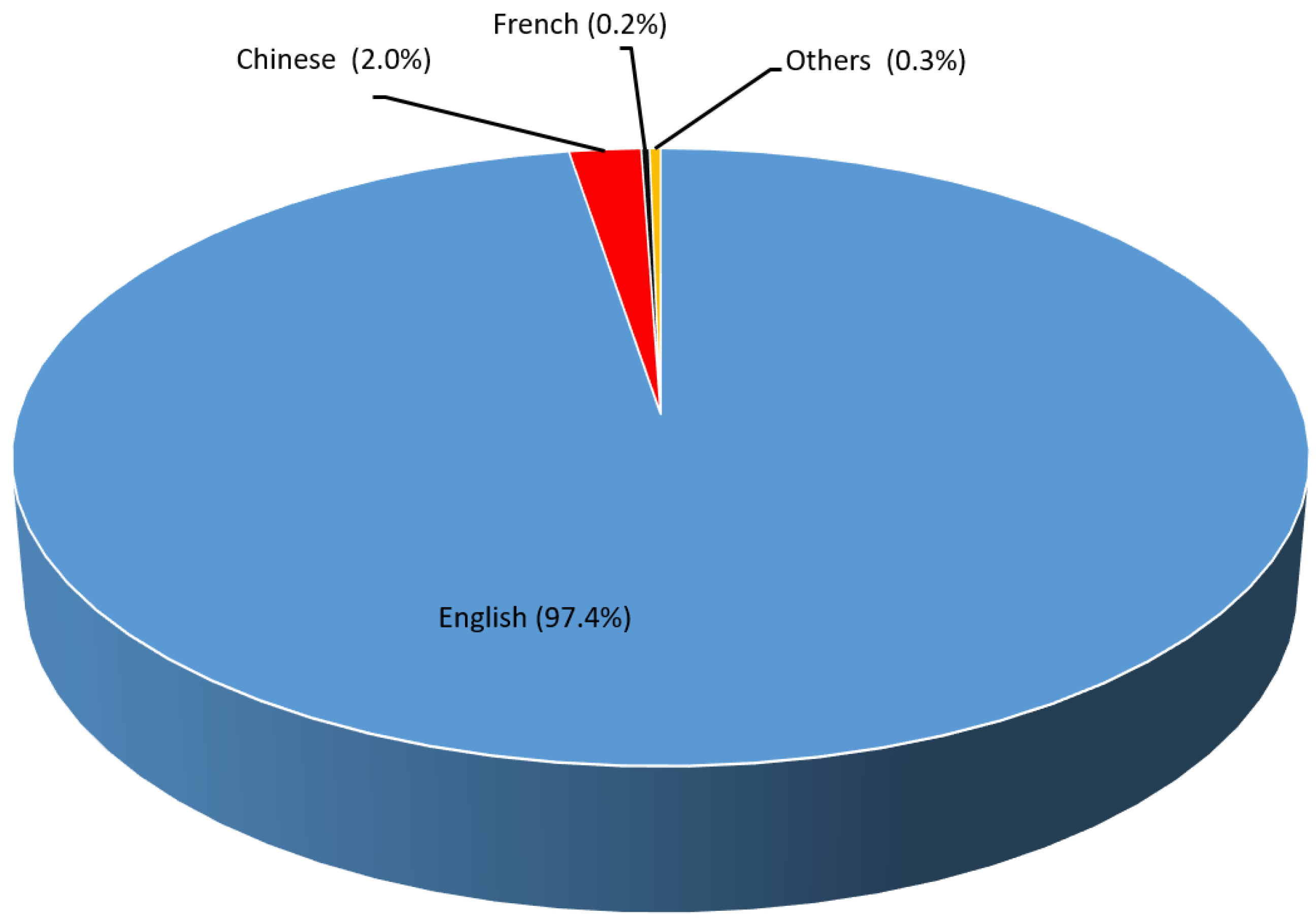
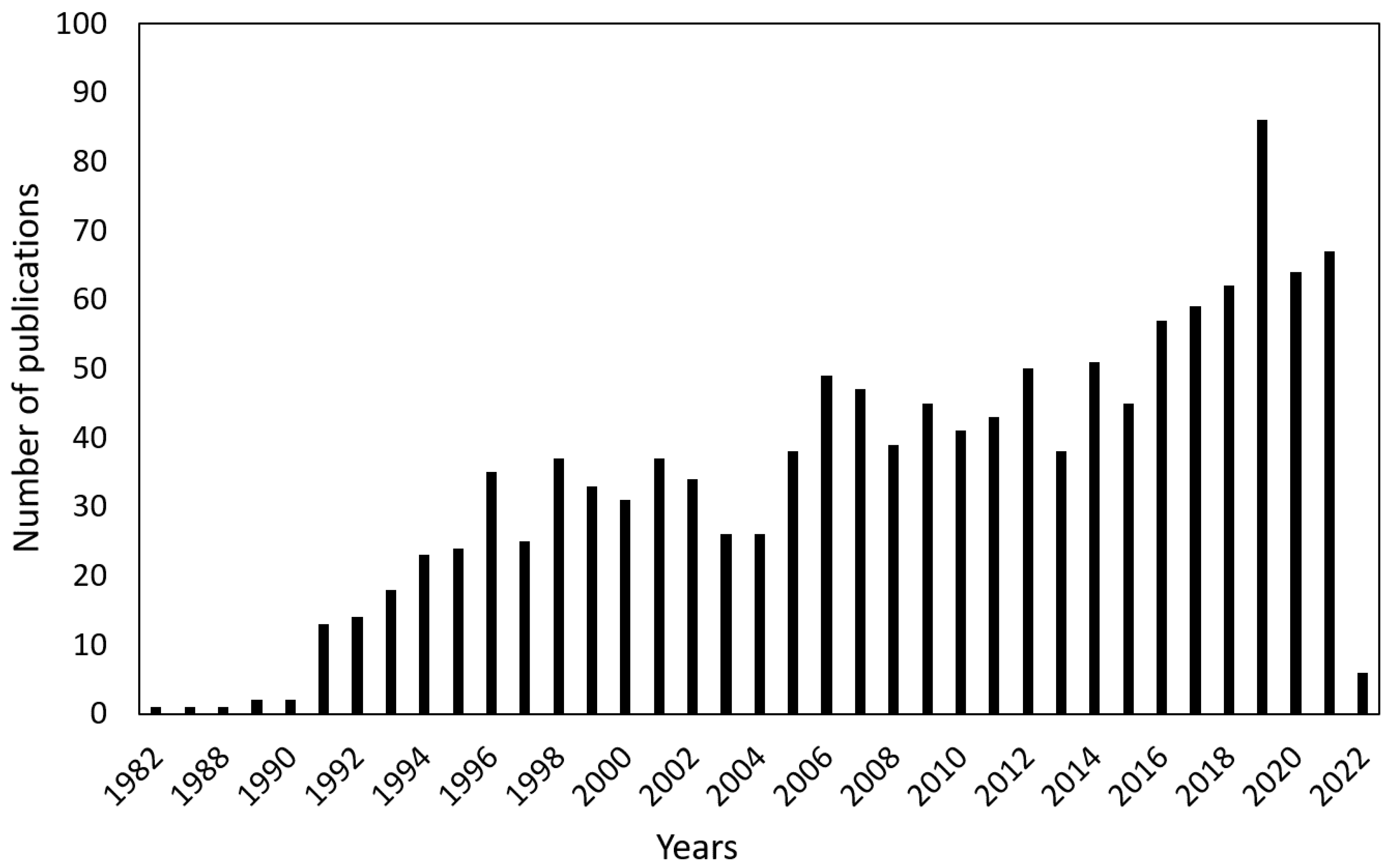
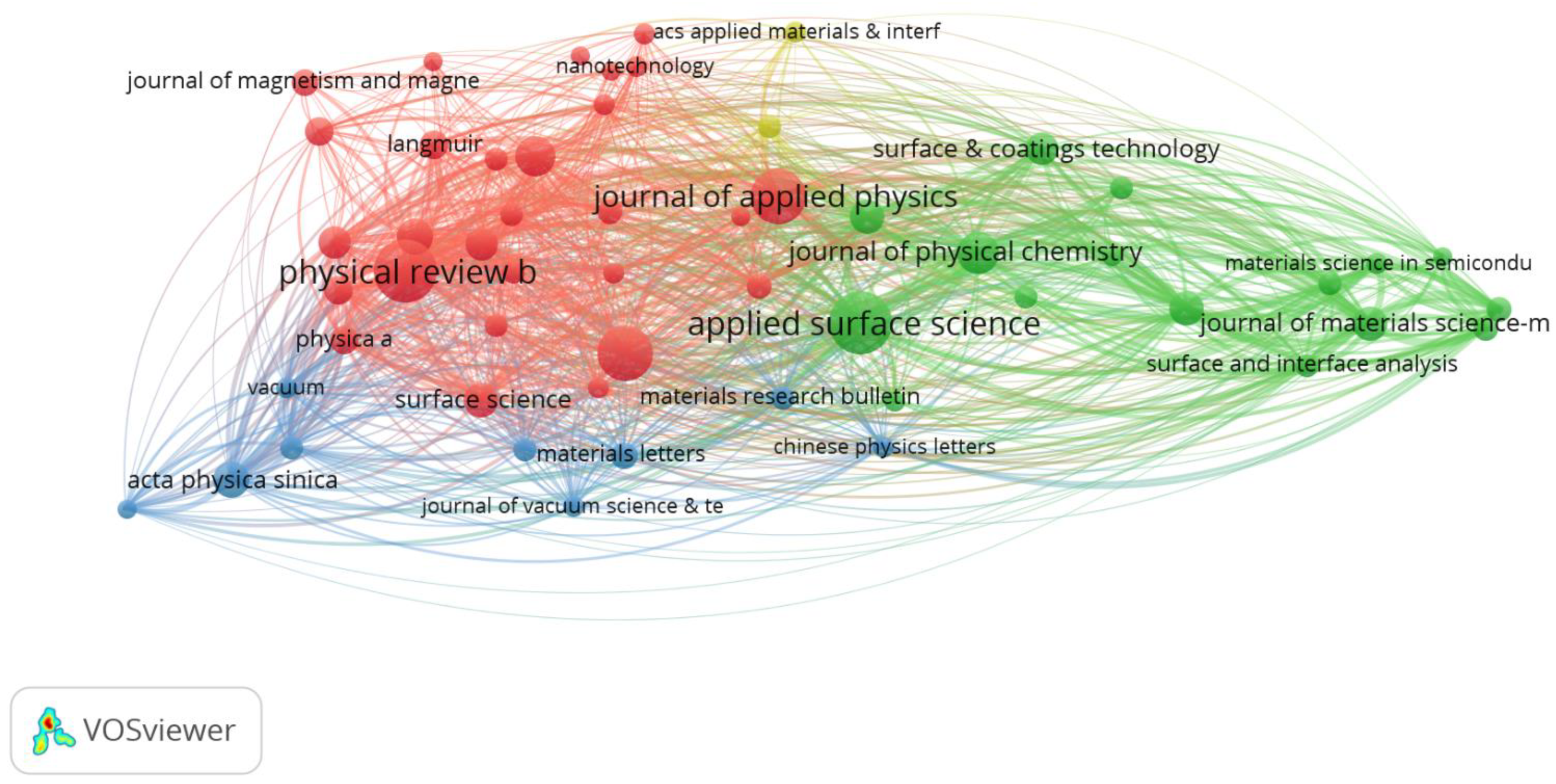
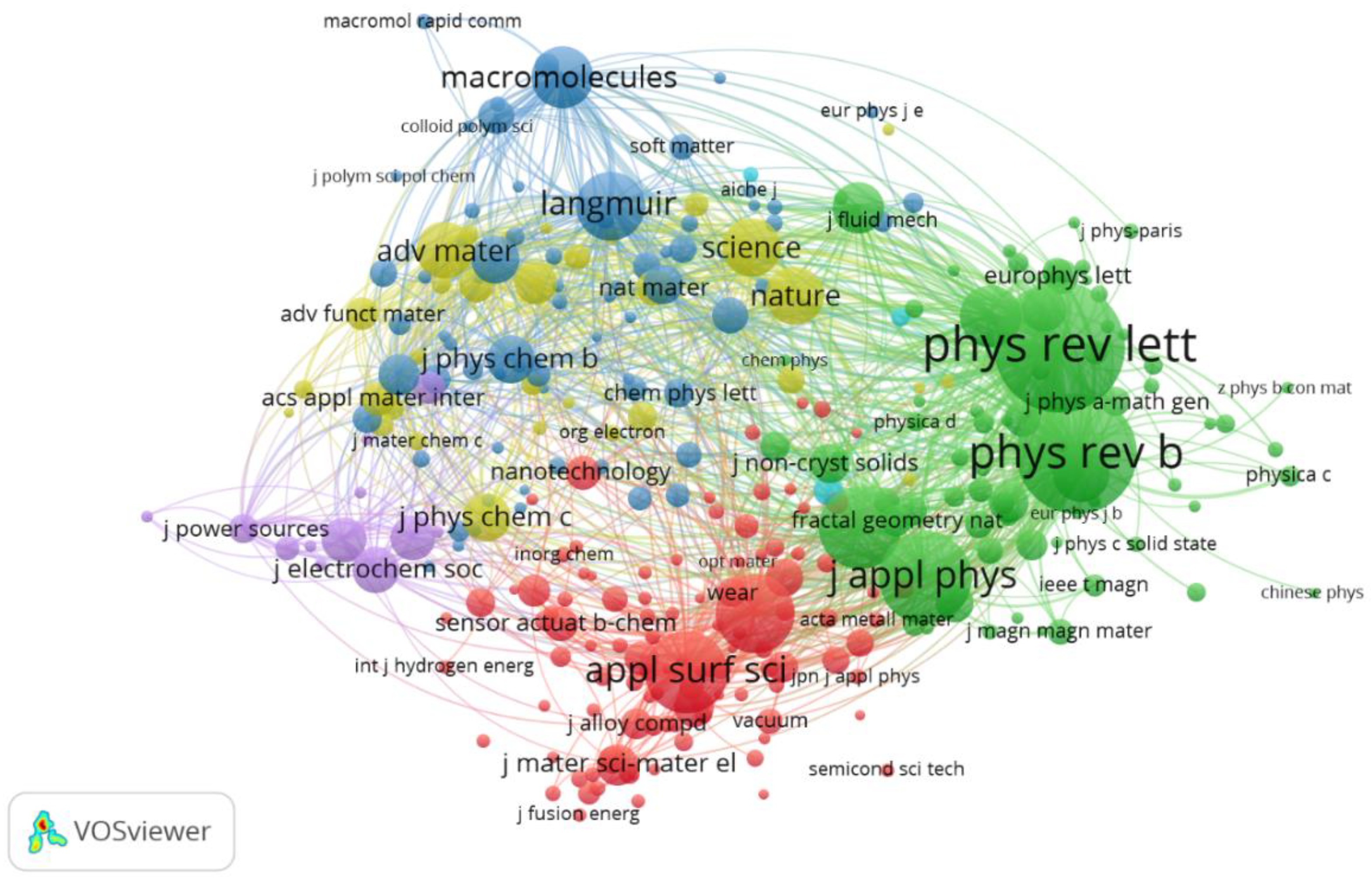

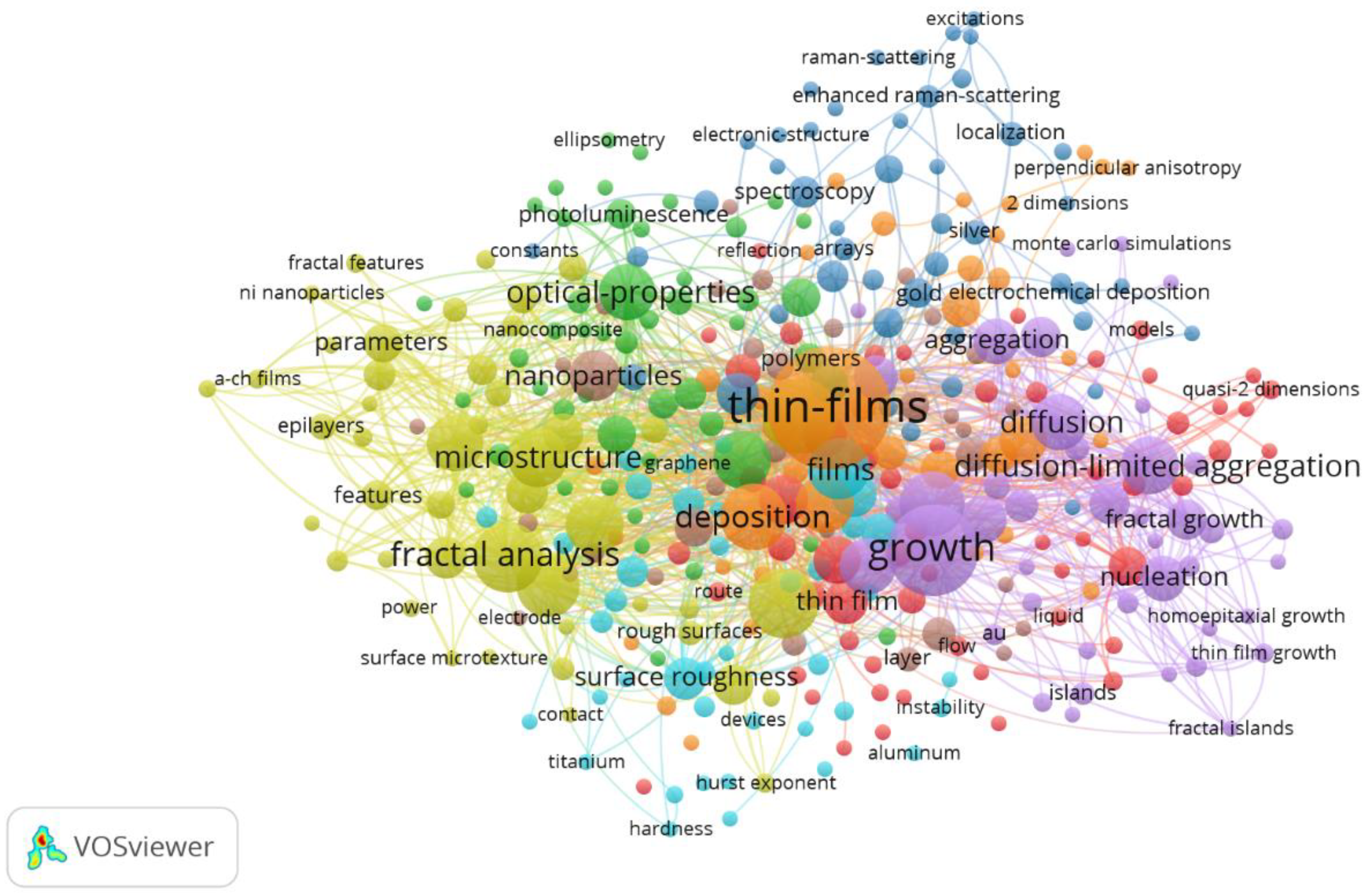


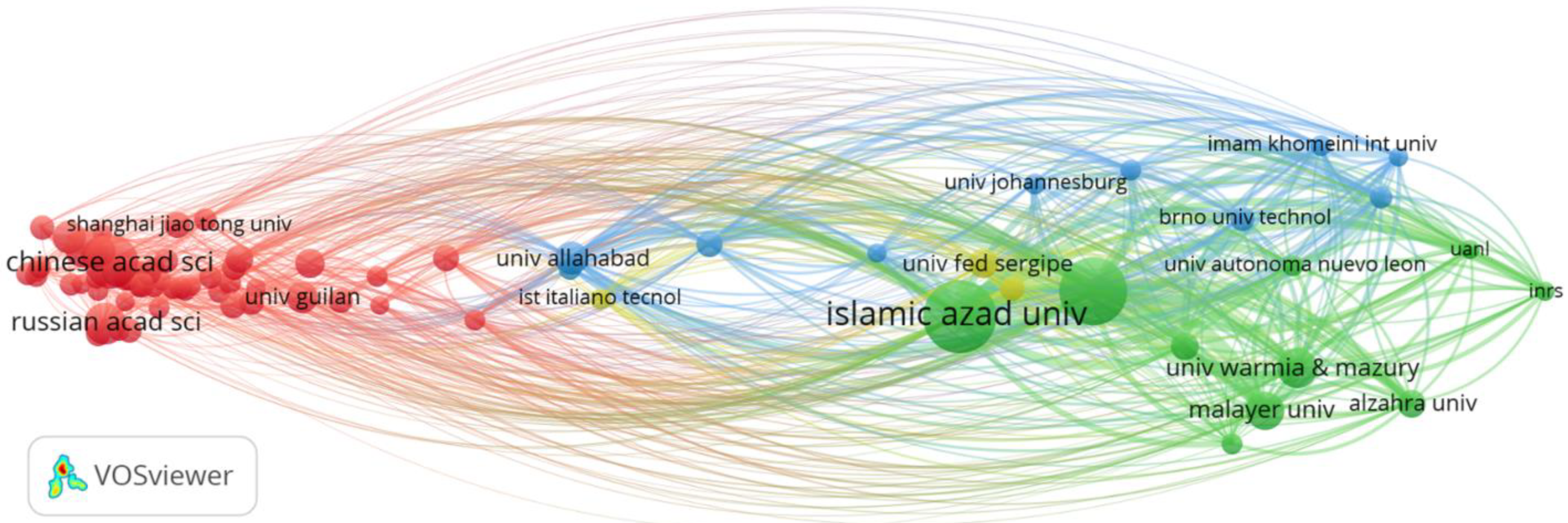


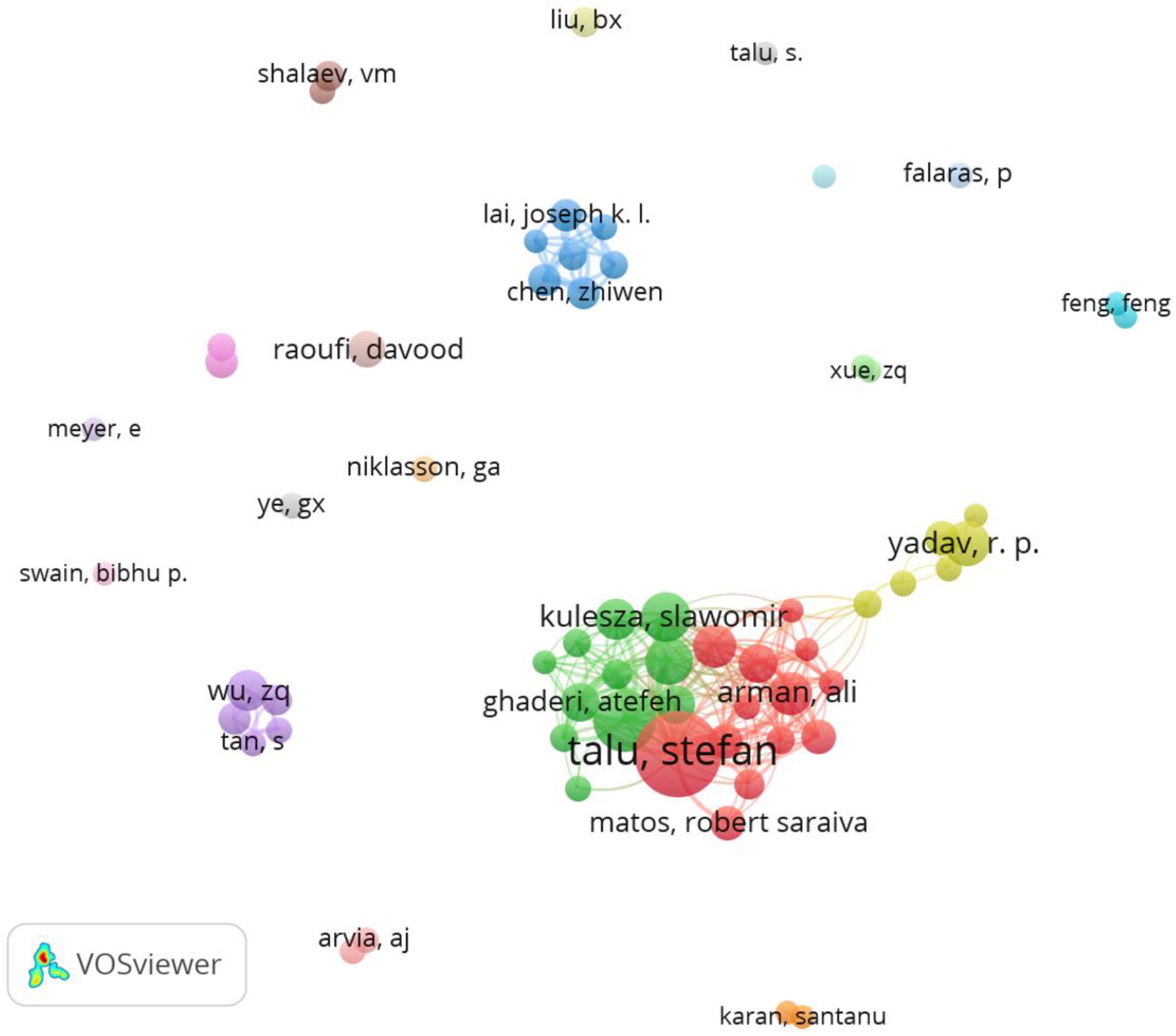

| Rank | Title of Article | Author/Year | Journal | Research Area | Country/Institution | Citations |
|---|---|---|---|---|---|---|
| 1 | Fractal Model of Elastic-Plastic Contact Between Rough Surfaces | Majumdar, A & Bhushan, B/1991 | Journal of Tribology-Transactions of the ASME | Engineering | USA/Arizona State University | 782 |
| 2 | Fractal design concepts for stretchable electronics | Fan, JA et al./2014 | Nature Communications | Science & Technology | USA/Howard Hughes Medical Institute | 592 |
| 3 | Silver-modified titanium dioxide thin films for efficient photodegradation of methyl orange | Arabatzis, IM et al./2003 | Applied Catalysis B-Environmental | Chemistry, Engineering | Greece/NCSR Demokritos, Inst Phys Chem | 433 |
| 4 | Impedance of constant phase element (CPE)-blocked diffusion in film electrodes | Bisquert, J et al./1998 | Journal of Electroanalytical Chemistry | Chemistry, Electrochemistry | USA/UnivJaume | 327 |
| 5 | Dynamic Scaling of The Island-Size Distribution and Percolation in A Model of Sub-monolayer Molecular-Beam Epitaxy | Amar, JG et al./1994 | Physical Review B | Materials Science, Physics | USA/Emory University | 310 |
| 6 | Robust fluorine-free superhydrophobic PDMS-ormosil@fabrics for highly effective self-cleaning and efficient oil-water separation | Cao, CY et al./2016 | Journal of Materials Chemistry A | Chemistry, Energy & Fuels, Materials Science | Peoples R China/Soochow University | 320 |
| 7 | Near-field optical spectroscopy of individual surface-plasmon modes in colloid clusters | Markel, VA/1999 | Physical Review B | Materials Science, Physics | University of Georgia | 291 |
| 8 | Fractal dimension and size scaling of domains in thin films of multiferroic BiFeO3 | Catalan, G/2008 | Physical Review Letters | Physics | England/University of Cambridge | 227 |
| 9 | Effect of roughness as determined by atomic force microscopy on the wetting properties of PTFE thin films | Miller, JD/1996 | Polymer Engineering and Science | Engineering, Polymer Science | USA/University of Utah | 222 |
| 10 | The Formation of Dew | Beysens, D/1995 | Atmospheric Research | Meteorology & Atmospheric Sciences | France/CEA, CTR ETUD SACLAY | 220 |
| Rank | Publication Titles | Record Count | Percentage (%) of Published Records |
|---|---|---|---|
| 1 | Applied Surface Science | 53 | 4.2 |
| 2 | Physical Review B | 53 | 4.2 |
| 3 | Journal of Applied Physics | 42 | 3.3 |
| 4 | Thin Solid Films | 42 | 3.3 |
| 5 | Journal of Physical Chemistry C | 25 | 2.0 |
| 6 | Applied Physics Letters | 22 | 1.7 |
| 7 | Acta Physica Sinica | 19 | 1.5 |
| 8 | Physical Review E | 19 | 1.5 |
| 9 | Journal of Materials Science Materials in Electronics | 17 | 1.3 |
| 10 | Applied Physics A Materials Science Processing | 16 | 1.3 |
| 11 | Materials Research Express | 16 | 1.3 |
| 12 | Surface Science | 16 | 1.3 |
| 13 | Physical Review Letters | 15 | 1.2 |
| 14 | Macromolecules | 14 | 1.1 |
| 15 | Surface Coatings Technology | 14 | 1.1 |
| 16 | Journal of Physical Chemistry B | 12 | 0.94 |
| 17 | Langmuir | 12 | 0.94 |
| 18 | Physica A: Statistical Mechanics and its Applications | 12 | 0.94 |
| 19 | Journal of Physics Condensed | 11 | 0.87 |
| 20 | Journal of Magnetism and Magnetic Materials | 10 | 0.79 |
| Rank | Publishers | Record Count | Percentage |
|---|---|---|---|
| 1 | Elsevier | 439 | 33.2 |
| 2 | Springer Nature | 118 | 8.9 |
| 3 | Amer Inst Physics | 100 | 7.6 |
| 4 | Amer Chemical Soc | 97 | 7.3 |
| 5 | IOP Publishing Ltd. | 71 | 5.4 |
| 6 | Wiley | 71 | 5.4 |
| 7 | Amer Physical Soc | 64 | 4.8 |
| 8 | Taylor & Francis | 33 | 2.5 |
| 9 | Royal Soc Chemistry | 28 | 2.1 |
| 10 | Multidisciplinary Digital Publishing | 23 | 1.7 |
| Rank | Web of Science Categories | Record Count | Percentage Count |
|---|---|---|---|
| 1 | Physics Applied | 425 | 33.5 |
| 2 | Materials Science Multidisciplinary | 424 | 33.4 |
| 3 | Physics Condensed Matter | 315 | 24.8 |
| 4 | Chemistry Physical | 227 | 17.9 |
| 5 | Materials Science Coatings Films | 133 | 10.5 |
| 6 | Physics Multidisciplinary | 132 | 10.4 |
| 7 | Nanoscience Nanotechnology | 102 | 8.0 |
| 8 | Chemistry Multidisciplinary | 74 | 5.8 |
| 9 | Engineering Electrical Electronic | 68 | 5.4 |
| 10 | Polymer Science | 68 | 5.4 |
| 11 | Optics | 42 | 3.3 |
| 12 | Physics Mathematical | 37 | 2.9 |
| 13 | Electrochemistry | 32 | 2.5 |
| 14 | Engineering Mechanical | 32 | 2.5 |
| 15 | Multidisciplinary Sciences | 32 | 2.5 |
| 16 | Engineering Chemical | 31 | 2.4 |
| 17 | Physics Atomic Molecular Chemical | 31 | 2.4 |
| 18 | Physics Fluids Plasmas | 25 | 2.0 |
| 19 | Metallurgy Metallurgical Engineering | 24 | 1.9 |
| 20 | Chemistry Analytical | 21 | 1.7 |
| 21 | Instruments Instrumentation | 21 | 1.7 |
| 22 | Mechanics | 21 | 1.7 |
| 23 | Microscopy | 20 | 1.6 |
| 24 | Materials Science Ceramics | 17 | 1.34 |
| 25 | Mathematics Interdisciplinary Applications | 16 | 1.26 |
| Rank | Research Areas | Record Count | Percentage Record Count |
|---|---|---|---|
| 1 | Physics | 726 | 57.2 |
| 2 | Materials Science | 530 | 41.7 |
| 3 | Chemistry | 307 | 24.2 |
| 4 | Engineering | 145 | 11.4 |
| 5 | Science Technology Other Topics | 134 | 10.6 |
| 6 | Polymer Science | 68 | 5.4 |
| 7 | Optics | 42 | 3.3 |
| 8 | Electrochemistry | 32 | 2.5 |
| 9 | Mathematics | 24 | 1.9 |
| 10 | Metallurgy Metallurgical Engineering | 24 | 1.9 |
| 11 | Instruments Instrumentation | 21 | 1.7 |
| 12 | Mechanics | 21 | 1.7 |
| 13 | Microscopy | 20 | 1.6 |
| 14 | Energy Fuels | 14 | 1.1 |
| 15 | Anatomy Morphology | 10 | 0.79 |
| 16 | Environmental Sciences Ecology | 10 | 0.79 |
| 17 | Thermodynamics | 10 | 0.79 |
| 18 | Computer Science | 9 | 0.71 |
| 19 | Crystallography | 9 | 0.71 |
| 20 | Life Sciences Biomedicine Other Topics | 9 | 0.71 |
| 21 | Nuclear Science Technology | 9 | 0.71 |
| 22 | Water Resources | 6 | 0.47 |
| 23 | Biochemistry Molecular Biology | 5 | 0.39 |
| 24 | Biophysics | 4 | 0.32 |
| 25 | Meteorology Atmospheric Sciences | 4 | 0.32 |
| Year | Authors | Thin Film Material | Method of Deposition | Imaging Technique |
|---|---|---|---|---|
| 1982 | RF Voss, et al. [58] | Gold (Au) | Electron-beam evapouration | Transmission electron microscopy (TEM) |
| 1989 | JR Ding, BX Liu [59] | Silver-cobalt (Ag-Co) | Evapouration | Transmission electron microscopy (TEM) |
| 1991 | BX Liu, J Wang, ZZ Fang [60] | Cobalt (Co) | Electron-gun evapouration | Transmission electron microscopy (TEM) |
| 2000 | G.A. Niklasson, et al. [61] | Tin dioxide (SnO2) | Spray pyrolysis | Atomic force microscopy, light scattering |
| 2009 | T Toyama, Y Sobajima, H Okamoto [62] | microcrystalline Si (μc-Si) | plasma-enhanced chemical vapour deposition (PECVD) | Atomic force microscopy (AFM) |
| 2009 | C Trapalis [63] | TiO2 | Sol-gel | Atomic force microscopy (AFM) |
| 2016 | GH Solookinejad, ASH Rozatian, MH Habibi [64] | ZnO | Sol-gel | Atomic force microscopy (AFM) |
| 2016 | J Arjomandi, D Raoufi, F Ghamari [65] | Pyrrole (Py) conductive polymer | Cyclic voltammetry | Atomic force microscopy (AFM) |
| 2019 | Kavyashree et al. [66] | Copper-doped strontium hydroxide (Cu:Sr(OH)2) | Successive ion layer adsorption and reaction (SILAR) | Scanning electron microscopy (SEM) |
| 2019 | R Prajapat, YC Sharma [67] | Cu2ZnSnSe4 | Sputtering and electron beam deposition | Atomic force microscopy (AFM) |
| 2019 | L Eftekhari, D Raoufi [68] | ZrO2 | Electron beam evapouration | Atomic force microscopy (AFM) |
| 2019 | B Astinchap [69] | Titanium | Magnetron sputtering | Atomic force microscopy (AFM) |
| 2019 | FM Mwema, ET Akinlabi, OP Oladijo [55] | Aluminium | RF magnetron sputtering | Field emission scanning electron microscopy (FESEM) and Atomic force microscopy (AFM) |
| 2020 | Ş Ţălu et al. [70] | Silver/diamond-like carbon nanocomposite | co-deposition by sputtering and RF-PECVD | Atomic force microscopy (AFM) |
| 2020 | F Ghribi et al. [71] | CuInS2 | RF magnetron sputtering | Atomic force microscopy (AFM) |
| 2020 | AR Jahangiri et al. [72] | AlZnO | Magnetron sputtering | Scanning electron microscopy (SEM) |
| 2021 | S Soumya et al. [73] | Molybdenum Oxide (MoO3) | Pulsed laser deposition | Atomic force microscopy (AFM) |
| 2021 | Z Ebrahiminejad, S Asgary, P Esmaili [74] | Cu-doped Indium sulphide | Chemical bath deposition | Atomic force microscopy (AFM) |
| 2021 | Y Romaguera-Barcelay et al. [75] | GdMnO3 | Spin coating | Atomic force microscopy (AFM) |
| 2021 | Y.Romaguera-Barcelay et al. [76] | BiZn0.5Ti0.5O3 | RF magnetron sputtering | Atomic force microscopy (AFM) |
| 2022 | E Teimouri et al. [77] | TiB2 | Laser ablation technique | Atomic force microscopy (AFM) |
| 2022 | A Das et al. [54] | 2D Cd1−xPbxS | Pulsed laser deposition (PLD) | Atomic force microscopy (AFM) |
| 2022 | F Ghribi et al. [78] | Co10%–Alx Co-doped Zinc Oxide | Pulsed laser deposition (PLD) | Atomic force microscopy (AFM) |
| Rank | Research Institution/University | Number of Outputs | % of Total Outputs |
|---|---|---|---|
| 1 | Islamic Azad University | 74 | 5.6 |
| 2 | Chinese Academy of Sciences | 70 | 5.3 |
| 3 | Technical University of Cluj Napoca | 64 | 4.8 |
| 4 | Centre National De La Recherche Scientifique CNSR | 52 | 3.9 |
| 5 | Russian Academy of Sciences | 41 | 3.1 |
| 6 | League of European Research Universities, LERU | 31 | 2.3 |
| 7 | Tsinghua University | 31 | 2.3 |
| 8 | United States Department of Energy, DOE | 31 | 2.3 |
| 9 | Indian Institute of Technology System IIT System | 27 | 2.0 |
| 10 | UDICE French Research Universities | 24 | 1.8 |
| Rank | Authors | Record Count | % of Total | WoSh-Index | Institution | Country | Total Citations |
|---|---|---|---|---|---|---|---|
| 1 | Ţălu S | 64 | 4.8 | 33 | Technical University of Cluj-Napoca | Romania | 1466 |
| 2 | Solaymani S | 35 | 2.6 | 29 | Islamic Azad University | Iran | 851 |
| 3 | Yadav RP | 26 | 2.0 | 14 | DeenDayal Upadhyay Govt PG Coll | India | 362 |
| 4 | Chen ZW | 23 | 1.73 | 12 | University of Science and Technology of China | China | 292 |
| 5 | Kulesza S | 22 | 1.66 | 19 | University of Warmia & Mazury | Poland | 588 |
| 6 | Bramowicz M | 21 | 1.59 | 20 | University of Warmia & Mazury | Poland | 586 |
| 7 | Matos RS | 18 | 1.36 | 10 | Universidade Federal de Sergipe | Brazil | 113 |
| 8 | Rezaee S | 18 | 1.36 | Islamic Azad University | 176 | ||
| 9 | Shek CH | 18 | 1.36 | 40 | Hong Kong Polytechnic University | Hong Kong | 223 |
| 10 | Arman A | 17 | 1.30 | 16 | Academic Center for Education, Culture & Research (ACECR), Sharif University | Iran | 298 |
Publisher’s Note: MDPI stays neutral with regard to jurisdictional claims in published maps and institutional affiliations. |
© 2022 by the authors. Licensee MDPI, Basel, Switzerland. This article is an open access article distributed under the terms and conditions of the Creative Commons Attribution (CC BY) license (https://creativecommons.org/licenses/by/4.0/).
Share and Cite
Mwema, F.M.; Jen, T.-C.; Kaspar, P. Fractal Theory in Thin Films: Literature Review and Bibliometric Evidence on Applications and Trends. Fractal Fract. 2022, 6, 489. https://doi.org/10.3390/fractalfract6090489
Mwema FM, Jen T-C, Kaspar P. Fractal Theory in Thin Films: Literature Review and Bibliometric Evidence on Applications and Trends. Fractal and Fractional. 2022; 6(9):489. https://doi.org/10.3390/fractalfract6090489
Chicago/Turabian StyleMwema, Fredrick M., Tien-Chien Jen, and Pavel Kaspar. 2022. "Fractal Theory in Thin Films: Literature Review and Bibliometric Evidence on Applications and Trends" Fractal and Fractional 6, no. 9: 489. https://doi.org/10.3390/fractalfract6090489
APA StyleMwema, F. M., Jen, T.-C., & Kaspar, P. (2022). Fractal Theory in Thin Films: Literature Review and Bibliometric Evidence on Applications and Trends. Fractal and Fractional, 6(9), 489. https://doi.org/10.3390/fractalfract6090489









